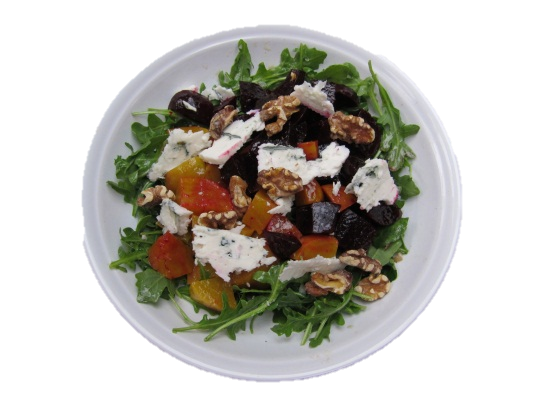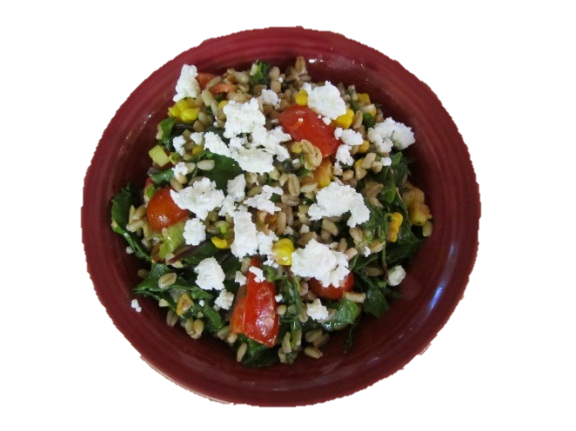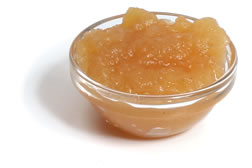This month is full of holidays calling for celebratory meals and special symbolic foods; we even have to plan for Yom Kippur, after which we’ll convene to break the fast. In this month’s column I’m sharing recipes for two delicious salads that would be perfect as part of a Rosh Hashanah meal, a break-the-fast buffet or as offerings featuring harvest foods for Sukkot. The sweet beets and honey in the first salad call to mind our wishes for a sweet year ahead. In addition, the Hebrew word for beet, “silka” sounds like “siluk”, the word for “removal”—we hope our adversaries will disappear in the year ahead. You can vary the veggies in the second salad according to what the harvest has yielded at the time you make it. It can even be prepared a couple of days ahead, making it perfect for after Yom Kippur.
The ultra-simple applesauce is a great accompaniment for a holiday brisket and is a real treat just on its own. Apples are available all year, but they are harvested around the time of the holidays, so it’s a good time to celebrate our bounty (and maybe put some in the freezer for the winter to serve with Hanukkah latkes!). Finally, I am repeating a formerly printed recipe for carrots, whose Yiddish translation, “mehren”, also means “to increase”, which is what we hope for in relation both to our numbers as a people and to our merit as individuals. The carrots are cooked with honey mustard, adding sweetness and can be prepared as a parve dish.
Two of the following recipes include nuts. Some people, Ashkenazim particularly, refrain from eating nuts for Rosh Hashanah because the numerical value of the word for “nut” in Hebrew is the same as for the word for “sin.” If this is your practice, omit the nuts or save the beet salad and carrots for Sukkot.
I hope you’ll try these recipes and that they will add to your enjoyment of all the holidays ahead this month.
ROASTED BEET, BLUE CHEESE and ARUGULA SALAD
This recipe was inspired by one that came with a bunch of supermarket golden beets and a recipe devised by author Dorie Greenspan and shared on her blog, In the Kitchen and on the Road with Dorie.
Serves 4 to 6 as a side dish, more as part of a buffet
1 lb beets, weighed without greens (red or golden, or a mix)
2 TBSP balsamic vinegar
¼ tsp kosher salt or to taste
2 TBSP extra virgin olive oil
2 TBSP walnut oil
Fresh-ground pepper
5 oz bag arugula or mixed baby salad greens
3 oz blue cheese or goat cheese, shaved into chards
½ C toasted walnut halves*
1 ½ TBSP honey, for drizzling
Scrub the beets, discard the leaves and trim stems to about 1inch. Place beets in an ovenproof casserole, add ¼”of water and cover tightly. Roast at 375° until the sharp point of a paring knife penetrates each beet easily. (Time will depend on the size of the beets—probably 35-50 minutes.) Allow beets to cool, then slip off the skins and trim the tops and bottoms to remove the roots and remaining stems. (Wearing your kitchen rubber gloves for this step will save you from stained hands.) Chill in refrigerator or place in heavy zip-lock bag and store in freezer for later use. (Thaw at room temperature before using; this will take several hours.)
While beets roast, make the dressing. Place vinegar and salt in a small bowl or jar and whisk to dissolve the salt. Slowly beat in the oils. Season with fresh-ground pepper to taste. Set dressing aside. This can be made a day ahead; whisk to re-combine as needed.
In a medium-size bowl, toss the greens with just enough dressing to coat them lightly and transfer to a serving platter. Cut the beets into cubes and toss with more of the dressing, coating them well. Arrange beets on top of the greens; sprinkle with walnuts and chards of cheese. Drizzle with a little more vinaigrette if you think it is needed, then drizzle lightly with honey. Toss at the table, or if serving as part of a buffet, leave as is and provide utensils that will make it easy for guests to help themselves to the layers of salad.
*Toast walnuts on a baking sheet in a 350° oven for about 10 minutes or until fragrant. Watch carefully to avoid burning them.
WHOLE GRAIN AND VEGETABLE SALAD
This salad can be prepared a couple of days ahead. It’s nourishing and it will hold up well for a couple of hours on the table. It is adapted from Tara Duggin‘s recipe in the San Francisco Chronicle. She suggests varying the vegetables by using cucumbers, grilled or sautéed marinated mushrooms, zucchini, eggplant, peppers, or baby arugula. Grains can be cooked ahead and stored in the refrigerator or freezer.
Serves 4 to 6
1 1/2 cups cooked whole grains, such as wheat berries, farro, brown rice and/or barley, prepared according to package directions and cooled
1 TBSP canola oil
2 cloves garlic, finely chopped
1 bunch Swiss chard stems removed; leaves chopped or torn into 2-inch pieces
Kernels from one ear of corn, or 1 C canned or thawed frozen corn*
Salt and pepper to taste
2 ripe tomatoes, chopped into 1/2 -inch dice (or use cherry tomatoes of varied colors)
2 green onions, thinly sliced
1TBSP chopped fresh oregano, thyme, rosemary or chives, or a mixture
4 teaspoons balsamic vinegar
4 tablespoons extra virgin olive oil
Crumbled fresh goat cheese or feta, or cubed fresh mozzarella (optional)
Place a large frying pan over medium heat, and add 1 TBSP canola oil. Add the garlic and sauté briefly, watching carefully to avoid burning it. Add the Swiss chard leaves, a few handfuls at a time, and cook, tossing the leaves frequently until they wilt, 1-2 minutes. Add the corn and just a splash of water. Cover and cook until the corn is done, about 2-3 minutes. Drain any accumulated liquid and season with salt and pepper.
Place the grains in a large bowl; add the Swiss chard mixture, tomatoes, green onions and herbs, and toss to combine. In a small bowl, mix the balsamic vinegar and olive oil; season with salt and pepper, then toss into the salad. Adjust seasonings.
Serve immediately, topped with the cheese, if using. The salad can also be stored without the cheese. Cool, cover and refrigerate for up to two days. Add the cheese at serving time.
*If fresh corn in the husk is available, it can be trimmed of its tassel and microwaved in the husk for 2 minutes. When it’s cooled sufficiently so it can be handled, strip off the husk and silk and cut off the kernels with a sharp knife. They can be used immediately or stored in a covered container for up to three days. The corn can be added to the frying pan without water or further cooking.
SWEET MUSTARD CARROTS
This is adapted from a 1993 recipe in SUNSET magazine.
Serves 8
2 –2 ½ lb small carrots, ¼" to ½" thick (2 – 3 bunches) 
1 C chicken or vegetable broth
1/4 C honey mustard
1 TBSP unsalted butter or margarine, cut into bits
1/3 C roasted and salted pistachios or almonds
Trim and peel the carrots. Cut any very thick ones in half lengthwise.
Place the carrots in a broad frying pan with a lid. Add the broth, whisk in the mustard, and scatter on the butter bits. Bring to a boil, cover, lower heat and simmer 5 to 12 minutes, or until carrots are just tender when pierced with the tip of a knife. Add more liquid if necessary.
Uncover and turn up heat to reduce the pan juices to a nice glaze. Shake the pan frequently to prevent sticking and scorching. Serve at once or cool, cover and store in refrigerator until next day. Reheat in pan over medium heat with 2 TBSP water, again shaking pan frequently.
Transfer carrots and sauce to a platter or a shallow vegetable dish and garnish with the chopped nuts.
BAKED APPLESAUCE
This is my simplified version of a recipe from The Santa Monica Farmers’ Market Cookbook: Seasonal Foods, Simple Recipes, and Stories from the Market and Farm by Amelia Saltsman. I think it’s a great idea to prepare applesauce by roasting because the flavor is concentrated. And it couldn’t be simpler!
Makes about 3 cups
3 lbs (8-9) Fuji apples 
Few sprigs thyme (optional)
Preheat oven to 375°F. Line a large rimmed baking sheet or pan with heavy foil (for easy cleanup). Cut apples in half vertically and remove cores (a melon baller does a good job). Place the halves, cut side down, in prepared pan, spacing them 1 to 2 inches apart. Scatter thyme among apples. Cover pan tightly with aluminum foil. If apples are large you may need more than one pan.
Bake apples until tender, about 30 minutes. When cool enough to handle, slip the skins from the apple halves, scraping any pulp back into the pan. Discard skins and thyme. Mash apples with a fork, stirring in a bit of water or lemon juice if you choose to lighten the texture of the applesauce. I like the thick rough texture from mashing, so I don't add any liquid. If there are any brown bits clinging to the foil, be sure to incorporate them into the applesauce.
This can be prepared several days ahead and stored in the refrigerator. It also freezes very well. I find it almost irresistible as a snack.
